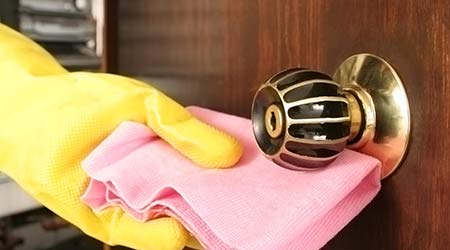« Back to Facilities Management Maintenance & Operations Category Home
Preventing the Spread of Flu All Season Long
April 11, 2018
- Maintenance & Operations
By Lori Strazdas
The 2017-2018 flu season has been one of the worst in nearly a decade, with February 2018 seeing the highest number of flu-related hospitalizations ever recorded by the CDC at that point in the season, and with more states than ever reporting widespread flu activity during the same period. Since flu activity can last through May, it’s important to remember that preventive measures can have just as much impact as they did when the flu season first began.
Influenza is mainly spread from person to person through the air, by droplets that are expelled when people with the flu cough and sneeze. Flu viruses can also spread via contaminated surfaces, when someone touches a surface or object that has flu virus on it and then touches their mouth, nose, or eyes.
Busy facilities, such as schools, gyms, and some offices can present a perfect storm environment for the spread of flu viruses, and are conducive to outbreaks with a high number of people in enclosed shared spaces. Beyond vaccination, maintaining healthy hygiene habits like proper handwashing, and cleaning and disinfecting surfaces, are other keys to prevention. With hand hygiene efforts largely left up to building occupants and visitors themselves, those responsible for cleaning can play an important role when it comes to cleaning and disinfecting shared communal surfaces.
Surface Disinfection
Cleaning and disinfecting surfaces that can harbor germs is important, especially since some germs can survive on surfaces for extended periods. For instance, influenza viruses can survive on hard surfaces such as stainless steel and plastic for up to 48 hours, and norovirus particles can persist on environmental surfaces for days to weeks. With survival times such as these, it is easy to see how some germs can be picked up and spread from person to person.
To help mitigate the impact of flu and other common illnesses, it is important to conduct regular cleaning and disinfection on a daily basis, especially during flu season. Commonly touched objects and surfaces — such as doorknobs, keyboards, faucets, phones, and elevator buttons — can yield a high number of germs and should be disinfected thoroughly with an Environmental Protection Agency (EPA) registered disinfectant.
Product Selection
While cleaning and compliance protocols and proper training of cleaning personnel are also essential, choosing the right cleaning and disinfection products is the first step in an effective cleaning program. Choose disinfectants that are EPA-registered (as noted on the product label) to kill bacteria and viruses like influenza and rhinovirus (the leading cause of the common cold) quickly. Product labels will provide the EPA-registration number as well as the directions for use, which includes the contact time, or the length of time the disinfectant needs to remain wet on the surface to effectively kill germs.
Ready-to-use products and pre-saturated disinfecting wipes are good options for disinfecting high-touch surfaces because they are easy to use, require no dilution, and deliver the proper concentration each time they are used. Pre-saturated disinfecting wipes can be left out in common areas for use by building occupants to help with cleaning and disinfecting surfaces throughout the day.
Countless shared spaces within athletic, business, and educational facilities leave a lot of room for bacteria and viruses to survive in hard-to-reach places. To ensure that large shared spaces are disinfected completely, many facilities are choosing to invest in innovative electrostatic spraying system rather than relying on manual cleaning alone. Electrostatic spray technology is a cost-effective solution for efficient, comprehensive surface treatment that is designed to help keep facilities healthier and cleaner.
Not only can investing in a consistent cleaning protocol, training of personnel, and strong product portfolio help facilities finish strong this flu season, but these steps can also help prevent businesses from facing costly outbreaks such as norovirus throughout the year.
Lori Strazdas, MPH, is a public health liaison with Clorox Professional Products Company. To learn more about flu prevention, www.CloroxProfessional.com.








